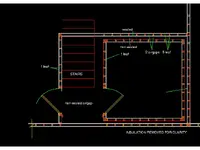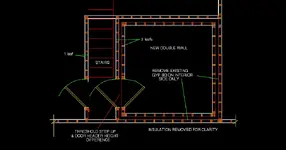A
adamski
New member
Hi
I'm currently in the process of building a studio. The design is a room within an existing room (drywall), which has an upstairs mezzanine floor (studio is on lower floor) - therefore there is a gap of about 2 feet between the existing wall that holds the door and the inner room, to allow for the stairs. I have also used a ratio of 1.0x1.5x1.6, with actual dimensions: height=2m, width=3.2m length=3m.
Currently I have a floating floor made with 2x4 joists resting on auralex U-boats with 22mm floorboards on top. This sits on an existing concrete floor. I am in the process of constructing the frames for my walls.
Now - I was given the advice that it is better to have drywall (2 layers) only on the inside of the frame, so that the main walls go like this: 2 x drywall - frame + rockwool - air gap - existing wall.
Now I have been given conflicting advice that it would be better (if I can afford it) to also have an outer layer of drywall on the outside of the frame.
2 x drywall - frame + rockwool - drywall - air gap - existing wall.
There will be an outer layer on the front wall anyway, so might it be better to extend this all the way round?
Cost is a major factor, but so is decent isolation. However, I will only be doing production and mixing in this room, not very much recording, so I dont need super-hardcore soundproofing here.
Thanks!
I'm currently in the process of building a studio. The design is a room within an existing room (drywall), which has an upstairs mezzanine floor (studio is on lower floor) - therefore there is a gap of about 2 feet between the existing wall that holds the door and the inner room, to allow for the stairs. I have also used a ratio of 1.0x1.5x1.6, with actual dimensions: height=2m, width=3.2m length=3m.
Currently I have a floating floor made with 2x4 joists resting on auralex U-boats with 22mm floorboards on top. This sits on an existing concrete floor. I am in the process of constructing the frames for my walls.
Now - I was given the advice that it is better to have drywall (2 layers) only on the inside of the frame, so that the main walls go like this: 2 x drywall - frame + rockwool - air gap - existing wall.
Now I have been given conflicting advice that it would be better (if I can afford it) to also have an outer layer of drywall on the outside of the frame.
2 x drywall - frame + rockwool - drywall - air gap - existing wall.
There will be an outer layer on the front wall anyway, so might it be better to extend this all the way round?
Cost is a major factor, but so is decent isolation. However, I will only be doing production and mixing in this room, not very much recording, so I dont need super-hardcore soundproofing here.
Thanks!



 A floating floor built with very little LEAF mass, actually can make things worse. If your WALLS and FLOOR are not built with LOW FREQUENCY in mind, then it will effectively be worse than building a room on an existing slab.
A floating floor built with very little LEAF mass, actually can make things worse. If your WALLS and FLOOR are not built with LOW FREQUENCY in mind, then it will effectively be worse than building a room on an existing slab.